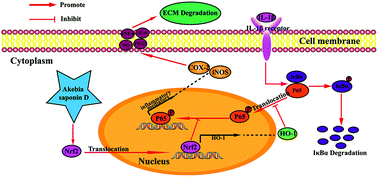Akebia Saponin D suppresses inflammation in chondrocytes via the NRF2/HO-1/NF-κB axis and ameliorates osteoarthritis in mice
Abstract
As an ordinary joint vestigial disease, osteoarthritis (OA) contributes to a considerable proportion of disability cases worldwide. Inflammation, as the main pathological factor, mediates the occurrence and development of OA. Akebia Saponin D (ASD), also known as Asperosaponin VI, is one of the active components extracted from Dipsaci Radix and is rich in Dipsacus loose tea. It has shown sound therapeutic effects on various diseases; nevertheless, its role in OA therapy is not completely understood. This study demonstrated the anti-inflammatory activity of ASD in OA through a series of in vivo and in vitro experiments. In vitro experiments revealed that ASD might prohibit the production of inflammatory mediators in IL-1β treated chondrocytes such as COX-2, iNOS, NO, PGE2, IL-6, and TNF-α. Meanwhile, it may also inhibit the production of ADAMTS-5 and MMP13 and promote the production of Aggrecan and Collagen II. The mechanism study demonstrated that ASD exerted an anti-inflammatory effect by activating the NRF2 target, upregulating the expression of HO-1, and preventing P65 from binding to DNA. In vivo experiments demonstrated that ASD might improve the progression of OA in a DMM mouse model. These research results provide evidence for the potential application of ASD in OA therapy.



 Please wait while we load your content...
Please wait while we load your content...